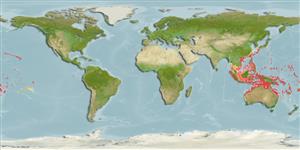Common names from other countries
Environment: milieu / climate zone / depth range / distribution range
Écologie
marin récifal; profondeur 3 - 46 m (Ref. 1602), usually 9 - 46 m (Ref. 1602). Tropical; 24°C - 28°C (Ref. 27115); 35°N - 32°S, 95°E - 139°W
Pacific Ocean: Christmas Island and Cocos-Keeling Islands in the eastern Indian Ocean to the Hawaiian and Tuamoto islands, north to Japan, south to Lord Howe Island. Replaced by Acanthurus tennenti in the Indian Ocean (Ref. 37816).
Taille / Poids / Âge
Maturity: Lm ? range ? - ? cm
Max length : 35.0 cm TL mâle / non sexé; (Ref. 2334); âge max. reporté: 33 années (Ref. 52229)
Épines dorsales (Total): 9; Rayons mous dorsaux (Total): 23-25; Épines anales 3; Rayons mous anaux: 22 - 24. Body of adult dark grayish brown; juveniles yellow; posterior to upper end of gill opening is a bright orange horizontal band, with purplish black border. Head and anterior half of body usually abruptly paler than the posterior half. Anterior gill rakers 24-28; posterior 23-27. Large adult males (about 17 cm) with more definite convexity of snout profile.
Inhabit seaward reefs, in areas of bare rock or mixed rubble and sand, from 9 to at least 46 m depth; juveniles inhabit protected bays and lagoons, singly or in small groups in as little as 3 m (Ref. 1602, 48637). Benthopelagic (Ref. 58302). Adults occur singly or in schools and feed on surface film of detritus, diatoms, and fine filamentous algae covering sand and bare rock (Ref. 1602). Rarely poisonous (Ref. 4795).
Life cycle and mating behavior
Maturité | Reproduction | Frai | Œufs | Fécondité | Larves
Randall, J.E., 1956. A revision of the surgeonfish genus Acanthurus. Pac. Sci. 10(2):159-235. (Ref. 1920)
Statut dans la liste rouge de l'IUCN (Ref. 130435)
CITES (Ref. 128078)
Not Evaluated
Utilisations par l'homme
Pêcheries: commercial; Aquarium: Commercial
Plus d'informations
RéférencesAquacultureProfil d'aquacultureSouchesGénétiqueElectrophoresesHéritabilitéPathologiesTraitementMass conversion
Outils
Articles particuliers
Télécharger en XML
Sources Internet
Estimates based on models
Preferred temperature (Ref.
115969): 24.5 - 28.7, mean 27.3 (based on 356 cells).
Phylogenetic diversity index (Ref.
82804): PD
50 = 0.5000 [Uniqueness, from 0.5 = low to 2.0 = high].
Bayesian length-weight: a=0.02570 (0.01656 - 0.03989), b=3.00 (2.87 - 3.13), in cm Total Length, based on LWR estimates for this species & Genus-body shape (Ref.
93245).
Niveau trophique (Ref.
69278): 2.3 ±0.17 se; based on food items.
Résilience (Ref.
120179): Haut, temps minimum de doublement de population inférieur à 15 mois (Preliminary K or Fecundity.).
Fishing Vulnerability (Ref.
59153): Low vulnerability (18 of 100).
